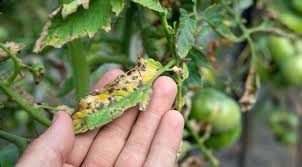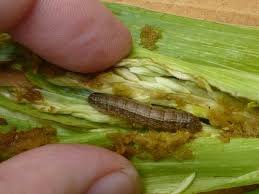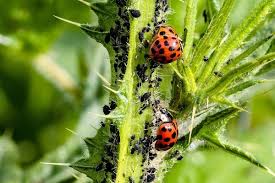Pest identification is the first step in any pest management situation. Accurate identification is the most important step, as misidentification is a common cause of control failure.
Insect identification is based on morphological features such as the structure of mouthparts, wings, legs, antennae, etc.
The type of damage observed in the field and the pest’s location on the plant also assist in determining which pests are present.
Many insect pests have chewing mouthparts and feed on plant tissue. Caterpillars of many butterflies and moths, as well as larval or adult stages of several beetles, feed on leaves, fruit, roots, or other specific plant parts.
Most plants also host one or more species of aphids, leafhoppers, or plant bugs. These insects have sucking mouthparts that puncture plant tissues and extract sap, causing damage to leaves, flowers, or fruit.
Sucking insects may also transmit diseases from infected to healthy plants. Different pest species often attack crops at a specific time of year, stage of plant growth, or under particular environmental conditions.
Other insects, such as wireworms, feed on roots. Cutworms feed at ground level, girdling young seedlings.
Misinterpretation of Symptoms in Pest Detection
Farmers sometimes mistake symptoms of nutritional deficiencies such as yellowing leaves, stunting, weak growth, and poor production as signs of insect pest presence, which is often not the case.
The most frustrating aspect of pest infestation is the difficulty in detecting it early. Larger pests, such as mice or rats, are nocturnal and typically go unnoticed. These situations make pest identification more difficult and complex.
Read Also: 12 Medicinal Health Benefits of Oats (Avena Sativa)
Common Signs to Detect Insect Pest Infestation on the Farm

1. Droppings and Odour in the Farm Environment
Most insects and pests leave signs of their presence through droppings. A noticeable collection of unknown droppings within a farm area should signal a potential infestation.
These droppings may be accompanied by a distinctive smell, which may even be detected before the droppings themselves. These are clear signs of insect pest presence on the farm or within the household.
2. Holes, Crevices, and Insect Tracks on Farmland Structures
Any gaps in the foundation or access points to farm buildings make it easy for pests to invade. Even a small hole may serve as an entry point for pests to burrow further.
Such activity may leave behind small piles of dirt or other materials. Tracks left by pests in search of food, water, or mates can also help identify how they entered or exited a building or field.
3. Nocturnal Sounds and Unusual Activity
Larger pests such as rats, mice, and raccoons are typically active at night. Their presence may be detected through sounds such as squeaking, scratching, or scurrying, especially from attics or walls.
To check for pests, inspect crawlspaces, attics, or any areas from which such sounds have been heard.
Basic Tools and Materials Required for Insect Pest Identification
The following items are essential for proper insect pest identification:
- Notebook
- Magnifying glass
- Camera
- Jar (for collecting samples)
- Insect field guide
Read Also: 12 Medicinal Health Benefits of Emilia Sonchifolia (lilac tasselflower)
Procedure for Identifying Insect Pests in Agriculture

1. Examine the Plant Thoroughly
If insect infestation is suspected, inspect the plant thoroughly. Check both the upper and lower sides of leaves for caterpillars, insects, or egg masses.
Observe any flying or crawling insects when leaves are disturbed. Take notes, photographs, or collect samples for comparison using a field guide or gardening reference.
Avoid applying insecticides until positive identification is made, as many insecticides harm both pests and beneficial insects like pollinators and predators.
2. Identify the Pest Type Based on Feeding Habits
Entomologists categorize insects by their feeding behavior:
1. Chewing insects: Feed on leaves, leaving holes, ragged edges, or a skeletonized appearance (e.g., weevils, caterpillars, flea beetles, Japanese beetles). Larger pests may leave frass (excrement).
2. Sucking insects: Pierce plant tissues and extract sap, leaving signs such as stippling, silvery-bronze foliage, or discolored blooms (e.g., spider mites, aphids, thrips, leafhoppers). These pests may also leave molted skins.
The signs described in steps 1 and 2 should be carefully observed as warning indicators of pest presence. These differ from symptoms of nutrient deficiency and plant disease.
How to Differentiate Between Insect Pests, Nutrient Deficiencies, and Disease Symptoms
| Symptom/Signs | Disease | Nutrient Deficiency / Environmental Stress | Insect Pest Incidence |
|---|---|---|---|
| Physical damage to crop | * | * | ✓ |
| Evenly distributed among many plants | * | * | ✓ |
| Occur in clusters | ✓ | * | ✓ |
| Scattered in pockets in the field | * | * | ✓ |
| Localised, affects small number of plants | * | * | ✓ |
| Occur at specific time of the year | * | * | ✓ |
Integrated Pest Management (IPM) Approach in Agriculture

Insect pests cause significant crop losses through direct damage and disease transmission. While chemical control remains a traditional method, increased awareness of its limitations and environmental risks has led to the development of Integrated Pest Management (IPM).
IPM is a strategic approach that considers the entire farm ecosystem—how pests interact with crops, climate, and each other. It allows farmers to select the safest and most effective pest management methods.
Most farmers practice some form of IPM through routine operations. This strategy uses multiple control tactics with the aim of keeping pests below economically damaging levels while minimizing environmental harm.
Pesticides continue to play a role in agriculture, forestry, and public health; however, reliance on them is decreasing.
Pest resistance, improper application timing, and environmental wash-off can reduce pesticide effectiveness. Thus, IPM emphasizes pest assessment, informed decision-making, and monitoring.
Symptoms of Disease in Crop Plants and How to Identify Them
A plant disease is any abnormal condition that reduces the health, yield, or usefulness of a plant. It is often caused by fungi, bacteria, viruses, or nematodes.
Disease occurrence depends on the presence of the pathogen, suitable environmental conditions, and susceptible crops or varieties. Environmental stress and nutrient deficiencies may mimic disease symptoms, so accurate identification is essential.
Steps to Identify Plant Disease Symptoms
- Use a shovel to dig out both healthy and diseased plants, ensuring roots are intact.
- Compare both plants, noting physical differences.
- Look for disease signs such as galls, rot, discolored stems, lesions, leaf spots, cankers, and malformation.
- Collect samples and send them to a plant diagnostic lab for accurate identification.
Identifying insect pest signs can be challenging, especially when pests are nocturnal or hidden under leaves or larger plants. Continuous monitoring and surveillance are essential.
Accurate identification of warning signs helps in implementing the right control measures and supports the shift toward integrated pest management for sustainable agricultural practices.
Do you have any questions, suggestions, or contributions? If so, please feel free to use the comment box below to share your thoughts. We also encourage you to kindly share this information with others who might benefit from it. Since we can’t reach everyone at once, we truly appreciate your help in spreading the word. Thank you so much for your support and for sharing!

